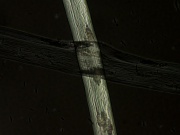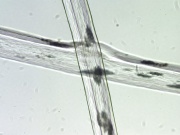Dynel
Description
[Union Carbide] A registered trademark for a synthetic modacrylic fiber composed of 40% Acrylonitrile and 60% Vinyl chloride copolymer. Dynel was first introduced in 1951. Its fibers are wet spun from an acetone solution; this produced irregular ribbon shaped filaments. The thermoplastic fibers were easily dyed and had good chemical resistance. Dynel fibers were also resistant to clothes moths larvae, to carpet beetles and to mildew and fungus. The fibers were sensitive to heat and could only be ironed at the lowest setting. Pleats could be permanently set with heat. Dynel was used in knitted and woven fabrics for apparel and household furnishing. It was also used to make fake fur, wigs and doll hair. The production of Dynel has been discontinued.
Risks
Fire resistant and self-extinguishing.
Physical and Chemical Properties
- Soluble in acetone, cyclohexanone. Insoluble in dry cleaning solvents, hydrocarbons, acids, alkalis and water.
- Fiber is ribbon shaped.
- Cross section if circular to flattened oval.
- Tenacity = 1.0-4.2 g/denier (dry or wet)
- Elongation = 14-120 % (dry or wet)
- Moisture regain = 0.4%
- Density = 1.31 g/ml
Resources and Citations
- G.S.Brady, Materials Handbook, McGraw-Hill Book Co., New York, 1971 Comment: p. 12
- J.Gordon Cook, Handbook of Textile Fibres:II Man-made Fibres, Merrow Publishing Co. , Durham, England
- The American Heritage Dictionary or Encarta, via Microsoft Bookshelf 98, Microsoft Corp., 1998

